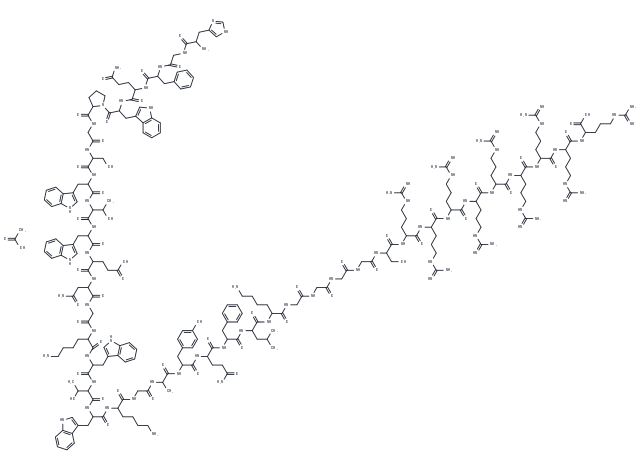keep away from moisture
Powder: -20°C for 3 years | In solvent: -80°C for 1 year

APTSTAT3-9R acetate is a selective peptide binding STAT3 with antiproliferative and antitumor activity. APTSTAT3-9R acetate and inhibits STAT3 activation and downstream signaling by specifically blocking STAT3 phosphorylation.

| Pack Size | Availability | Price/USD | Quantity |
|---|---|---|---|
| 1 mg | Inquiry | $ 227.00 | |
| 5 mg | Inquiry | $ 677.00 | |
| 10 mg | Inquiry | $ 997.00 | |
| 25 mg | Inquiry | $ 1,827.00 | |
| 50 mg | Inquiry | $ 2,742.00 | |
| 100 mg | Inquiry | $ 4,113.00 |
| Description | APTSTAT3-9R acetate is a selective peptide binding STAT3 with antiproliferative and antitumor activity. APTSTAT3-9R acetate and inhibits STAT3 activation and downstream signaling by specifically blocking STAT3 phosphorylation. |
| In vitro | APTSTAT3-9R acetate (7.5, 15, and 30 μmol/L) significantly reduces STAT3–DNA-binding activity in a dose-dependent manner in human lung carcinoma cells (A549) but does not affect the level of AKT phosphorylation, indicating specificity of the aptide. APTSTAT3-9R acetate (30 μM) suppresses cell viability and proliferation of cancer cells and significantly suppresses colony formation. The IC50s are 10 to 20 μM in A549, B16F1, and HepG2 cells[1]. |
| In vivo | In female BALB/c nude mice with A549 cells, APTSTAT3-9R acetate (8 mg/kg in 50 μL; intratumoral injection) suppresses tumor growth[1]. |
| Molecular Weight | 5007.56 |
| Formula | C225H334N80O53 |
keep away from moisture
Powder: -20°C for 3 years | In solvent: -80°C for 1 year
You can also refer to dose conversion for different animals. More
bottom
Please see Inhibitor Handling Instructions for more frequently ask questions. Topics include: how to prepare stock solutions, how to store products, and cautions on cell-based assays & animal experiments, etc.
APTSTAT3-9R acetate JAK/STAT signaling Stem Cells STAT APTSTAT39R acetate APTSTAT3 9R acetate APTSTAT3-9R Acetate inhibitor inhibit
